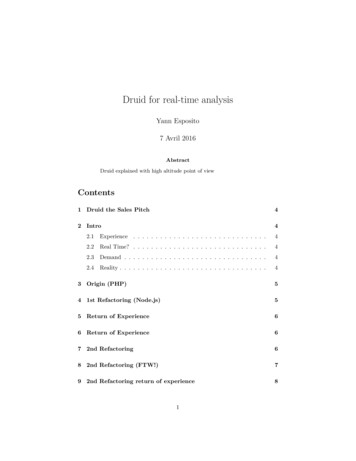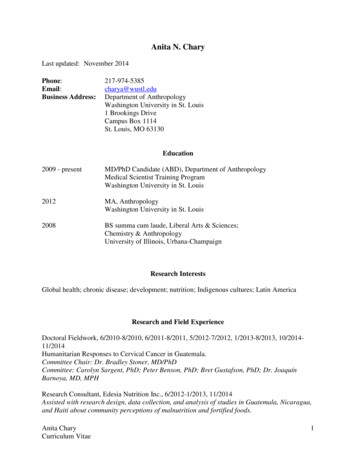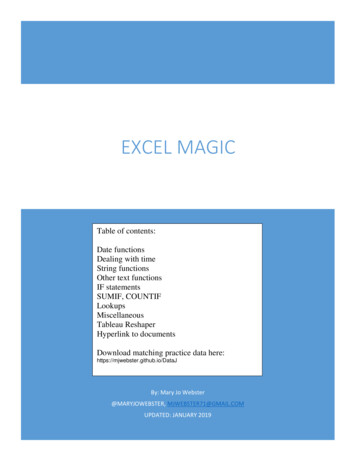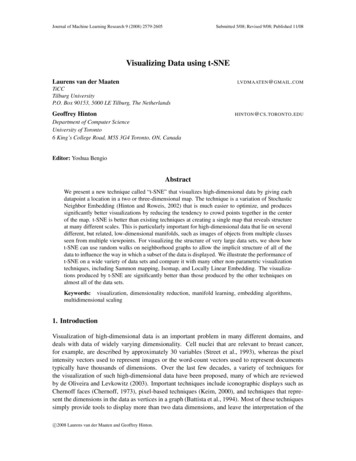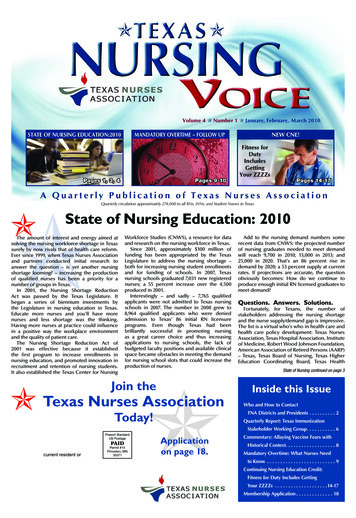
Transcription
Pages 1, 3, 4Pages 9-10Pages 14-17Quarterly circulation approximately 274,000 to all RNs, LVNs, and Student Nurses in Texas.State of Nursing Education: 2010The amount of interest and energy aimed atsolving the nursing workforce shortage in Texassurely by now rivals that of health care reform.Ever since 1999, when Texas Nurses Associationand partners conducted initial research toanswer the question – is yet another nursingshortage looming? – increasing the productionof qualified nurses has been a priority for anumber of groups in Texas.In 2001, the Nursing Shortage ReductionAct was passed by the Texas Legislature. Itbegan a series of biennium investments bythe Legislature in nursing education in Texas.Educate more nurses and you’ll have morenurses and less shortage was the thinking.Having more nurses at practice could influencein a positive way the workplace environmentand the quality of patient care.The Nursing Shortage Reduction Act of2001 was effective because it establishedthe first program to increase enrollments innursing education, and promoted innovation inrecruitment and retention of nursing students.It also established the Texas Center for NursingWorkforce Studies (CNWS), a resource for dataand research on the nursing workforce in Texas.Since 2001, approximately 100 million offunding has been appropriated by the TexasLegislature to address the nursing shortage –both for increasing nursing student enrollmentsand for funding of schools. In 2007, Texasnursing schools graduated 7,031 new registerednurses; a 55 percent increase over the 4,500produced in 2001.Interestingly – and sadly – 7,765 qualifiedapplicants were not admitted to Texas nursingschools in 2007. The number in 2008 grew to8,964 qualified applicants who were deniedadmission to Texas’ 86 initial RN licensureprograms. Even though Texas had beenbrilliantly successful in promoting nursingas a great career choice and thus increasingapplications to nursing schools, the lack ofbudgeted faculty positions and available clinicalspace became obstacles in meeting the demandfor nursing school slots that could increase theproduction of nurses.Join theTexas Nurses AssociationToday!Add to the nursing demand numbers somerecent data from CNWS: the projected numberof nursing graduates needed to meet demandwill reach 9,700 in 2010; 13,000 in 2013; and25,000 in 2020. That’s an 86 percent rise indemand by 2020; a 53 percent supply at currentrates. If projections are accurate, the questionobviously becomes: How do we continue toproduce enough initial RN licensed graduates tomeet demand?Questions. Answers. Solutions.Fortunately, for Texans, the number ofstakeholders addressing the nursing shortageand the nurse supply/demand gap is impressive.The list is a virtual who’s who in health care andhealth care policy development: Texas NursesAssociation, Texas Hospital Association, Instituteof Medicine, Robert Wood Johnson Foundation,American Association of Retired Persons (AARP)– Texas, Texas Board of Nursing, Texas HigherEducation Coordinating Board, Texas HealthState of Nursing continued on page 3Inside this IssueWho and How to ContactTNA Districts and Presidents . . . . . . . . . . 2Quarterly Report: Texas ImmunizationStakeholder Working Group . . . . . . . . . . . 6Presort StandardUS PostagePAIDcurrent resident orPermit #14Princeton, MN55371Applicationon page 18.Commentary: Allaying Vaccine Fears withHistorical Context. . . . . . . . . . . . . . . . . . . 8Mandatory Overtime: What Nurses Needto Know . . . . . . . . . . . . . . . . . . . . . . . . . . 9Continuing Nursing Education Credit:Fitness for Duty Includes GettingYour ZZZZs . . . . . . . . . . . . . . . . . . . .14-17Membership Application . . . . . . . . . . . . . . 18
Page 2 Texas Nursing VoiceJanuary, February, March 2010Texas Nurses Association Districts and PresidentsPresidents of the 29 state-wide Districts of Texas Nurses Association, as wellas some District offices, are listed below. They invite you to contact them withquestions or comments about TNA District membership and involvement.District 1:Patricia ShanabergerPhone: 915.831-4495E-mail: pshanabe@epcc.eduDistrict 2:Heidi TaylorPhone: 806.651-3500E-mail: htaylor@wtamu.eduDistrict 3:Lygia DunsworthPhone: 817.452-7866E-mail: lygia.dunsworth@baylorhealth.eduDistrict Address:Renee JamesPO Box 16958Ft. Worth, TX 76162Office: 817.249-5071E-mail: tna3@usapathway.com.Web site: www.tna3.orgDistrict 4:Colleen HinesPhone: 972.348-1614E-mail: cmhteh@sbcglobal.netDistrict Address:Pat PollockPO Box 35503Dallas, TX 75235Office: 972.435-2216E-mail: d4tna@flash.netWeb site: www.tnad4.orgDistrict 5:Serena BumpusPhone: 512.324-7183E-mail: sbumpus@seton.orgWeb site: www.tna5.orgDistrict 6:Ellarene Duis SandersPhone: 409.740-4056E-mail: Ellarene@live.comWeb site: www.tna6.orgDistrict 7:Charlotte SedillosPhone: 254.760-4344E-mail: csedillos@hillcrest.netWeb site: www.tnadistrict7.orgDistrict 8:Gayle DasherPhone: 210.705-6266E-mail: gdasher@satx.rr.comWeb site: www.texasnurses.org/districts/08/District 9:Brenda BinderPhone: 281.395-3734E-mail: bbinder@twu.eduDistrict Office:Melanie Truong2370 Rice Blvd., #109Houston, TX 77005Office: 713.523-3619E-mail: tna9@tnadistrict9.orgWeb site: www.tnadistrict9.orgDistrict 10:Lillian SifuentesPhone: t 11: VacantDistrict 12:Patricia MorrellPhone: ct 13: VacantDistrict 14:Joe LacherPhone: 956.882-5072E-mail: joe.lacher@utb.eduDistrict 15:Andrea KerleyPhone: 325.670-4230E-mail: akerley@hendrickhealth.orgWeb site: www.texasnurses.org/districts/15/District 16:Martha SleutelPhone: ct 17:Nancy GoodmanPhone: 361.825-2607E-mail: nancy.goodman@tamucc.eduWeb site: www.texasnurses.org/districts/17/District 18:Patty FreierPhone: 806.797-8120E-mail: pfreier@covhs.orgWeb site: www.texasnurses.org/districts/18/District 19:Nina Wallace GrossPhone: 903.877-5102E-mail: nina.wallace@uthct.eduWeb site: www.texasnurses.org/districts/19/District 20:Denise NeillPhone: 361.570-4277E-mail: NeillD@uhv.eduDistrict 21:Sherrie HarrisPhone: 432.640-1138E-mail: sherre@clearwire.netDistrict 22:Toni McDonaldE-mail: tmcdonald@hcecwildblue.comDistrict 25:Inger ZeruchaPhone: 903.315-2632E-mail:zinger65@sbcglobal.netDistrict 26:Cecilia HinojosaPhone: 956.454-0330E-mail:chinojosarn@netzero.comDistrict 28:Jenny WilderPhone: 903.826-2712E-mail:jennyrwilder@gmail.comDistrict 29:Beverly HowardPhone: t 35:Kim GatlinPhone: 903.466-6982E-mail: kgatlin@ntcc.eduDistrict 40:Contact TNAPhone 800.862-2022 ext. 129E-mail:brichey@texasnurses.orgTEXAS NURSING VoiceA publication of Texas Nurses AssociationJanuary, February, March 2010Volume 4, Number 1Editor-in-Chief – Clair B. Jordan, MSN, RNManaging Editor – Joyce CunninghamCreative Communications – Deborah TaylorCirculation Manager – Belinda RicheyEditorial ContributorsJoyce Cunningham; Toni Inglis, MSN, RN; Clair Jordan,MSN, RN; Laura Lerma, MSN, RN; Debora Simmons,PhD(c), RN, CCRN, CCNS; Lisa Watson;James H. Willmann, JD; Cindy Zolnierek, MSN, RNEditorial Advisory BoardStephanie Woods, PhD, RN, Dallas, (Chair)Jose Alejandro, MSN, RN, MBA, CCM, DallasPatricia Allen, EdD, RN, CNE, ANEF, LubbockSandra Kay Cesario, PhD, RN, C, PearlandJennifer D.M. Cook, PhD, MSN, RN, San AntonioAnita J. Coyle, PhD, RN, CHES, SangerThelma L. Davis, LVN, GiddingsAnita T. Farrish, RN, MHSM, NE-BC, WacoPatricia Goodpastor, RN, The WoodlandsPatricia Holden-Huchton, RN, DSN, DentonTara A. Patton, BSN, RN, PalestineDianna Lipp Rivers, RN, CNAA, BC, BeaumontExecutive OfficersSusan Sportsman, PhD, RN, PresidentMargie Dorman-O’Donnell, MSN, RN,Vice PresidentClaudia Turner, MSN, RN, Secretary-TreasurerRegional Directors of Texas Nurses AssociationKleanthe Caruso, MSN, RN, CNAA, BC, CCHP –NorthJennifer Cook, PhD, MSN, RN – SouthDana Danaher, MSN, RN, CPHQ – CentralViola Hebert, MA, BSN, RN – EastJo Rake, MSN, RN – WestExecutive DirectorClair B. Jordan, MSN, RNTEXAS NURSING Voice is published quarterly –January, February, March; April, May, June; July, August,September; and October, November, December by –Texas Nurses Association, 7600 Burnet Road, Suite 440,Austin, TX 78757-1292.Editorial OfficeTEXAS NURSING Voice, 7600 Burnet Road, Suite 440,Austin, TX 78757-1292512.452-0645, e-mail tnveditorial@texasnurses.orgAddress ChangesSend address changes toTexas Nurses Association, 7600 Burnet Road,Suite 440, Austin, TX 78757-1292,e-mail: tnvcirculation@texasnurses.orgAdvertisingArthur L. Davis Publishing Agency, Inc.,517 Washington St.P.O. Box 216, Cedar Falls, Iowa 50613800.626-4081, E-mail: sales@aldpub.comTexas Nurses Association and the Arthur L. DavisPublishing Agency, Inc. reserve the right to reject anyadvertisement. Responsibility for errors in advertisingis limited to corrections in the next issue or refund ofprice of advertisement.Acceptance of advertising does not implyendorsement or approval by Texas Nurses Association(TNA) of products advertised, the advertisers, or theclaims made. Rejection of an advertisement does notimply a product offered 8”forAdsadvertising is without merit,or that the manufacturerlacks integrity, or that thisOPENassociation disapproves of the product or its use. TNAand the Arthur L. Davis Publishing Agency, Inc. shallnot be held liable for any consequences resulting frompurchase or use of an advertiser’s product. Articlesappearing in this publication express the opinions ofthe authors; they do not necessarily reflect the views ofthe staff, board, or membership of TNA or those of thenational or local associations.Copyright 2010 by Texas Nurses Association.
January, February, March 2010State of Nursing continued from page 1Care Policy Council of the Governor’s Office,to mention but a few. All of these groups areunified in their understanding that demand fornurses will outpace supply if nothing is done.Their approaches vary somewhat but containcommon threads of innovation, collaboration,accountability and improved efficiencies assolution ingredients.Nursing Workforce ShortageCoalitionThe Nursing Workforce Shortage Coalition– a diverse partnership of over 100 health careorganizations, business groups and educationleaders – worked tirelessly this past legislativesession to increase the funding for nursingeducation in order to address the shortage. Thesolutions the coalition proposed are increasingnursing school capacity, improving efficiencies,assisting nursing students with financial aid andincentives in order to encourage enrollment andgraduation, and holding schools accountable forproducing more graduates.Texas Team – Center to ChampionNursing in AmericaIn the spring of 2008, the newly establishedCenter to Champion Nursing in America – ajoint initiative of AARP, Robert Wood JohnsonFoundation, U.S. Health Resources and ServicesAdministration, and the U.S. Department ofLabor – issued a call inviting states to joina nationwide effort to develop more localstrategies to prepare and retain nurses. Texasanswered the call and was one of only 18 statesselected to participate. By December 2008,Texas Nursing: Our Future Depends on It wasreleased. It is the strategic plan developed bythe Texas Team to address nursing educationcapacity. To meet demand, Texas needs to hire265 additional full-time and 159 part-time facultystatewide.“Texas must strive for synergies, partnerships,disruptions and innovation in order to meet thegoal of producing sufficient initial RN licensuregraduates,” states the report. The plan supportsgrowth, regionalization and partnershipsas the primary framework. The Texas Teamrecommends regionalization and sharing ofState of Nursing continued on page 4Texas Nursing Voice Page 3
Page 4 Texas Nursing VoiceState of Nursing continued from page 3resources to expand capacity and maximizeuse of limited resources. In short, “With acritical shortage of nurse educators, schools ofnursing must change or the state risks being leftbehind.”Collaborative members of Texas Teaminclude representatives of nursing educationand practice, state workforce offices, statedepartments of labor, consumers, local business,philanthropies and others.Texas Health Care Policy CouncilBy the end of each even-numbered year,the Texas Health Care Policy Council (THCPC)must report to the Governor, LieutenantGovernor, and Speaker on its findings andJanuary, February, March 2010recommendations for improving the healthcare system in Texas. In early December, BethMancinci, PhD, RN, NE-BC, FAHA, FAAN,professor and associate dean, UndergraduateNursing Programs, University of Texas atArlington, provided testimony on behalf ofTexas Nurses Association before the Council’sPartnership Workforce Subcommittee. Themain topic: faculty and nursing educationcapacity. The key question became: to expandcapacity in nursing schools, is there a facultyshortage, a compensation problem (i.e., afinancial disincentive to work in education),or a combination of both? In other words, ifexperienced nursing faculty is available, howdoes Texas attract it and what kind of fundingwould be needed?The answers – at least the possibilities –according to Mancini again come down toinnovation and collaboration. Faculty couldbe shared. So could resources. Educationalinnovations such as use of BSN-prepared nursesas part of faculty or flexible clinical rotationsthat allow more MSN-prepared nurses toparticipate in education could also be optionsfor expanding capacity.Outside InfluencesBesides a Texas Team in the Center toChampion Nursing in America, there’s a teamfrom Oregon. Named the Oregon Consortiumfor Nursing Education (OCNE), it launchedwhat’s referred to as “a groundbreakingprogram” to increase the number of BSNprepared nurses. Through collaboration, nursingfaculty from associate degree and baccalaureatenursing programs have agreed to new nursingcompetencies, shared curriculum and academicstandards. The results so far: a significantincrease in nurses pursuing bachelor’s degrees.Like in the testimony of Mancini, use of BSNprepared nurses as part of faculty could be someof the reform of nursing education needed for21st century health care.There is also urgency in strengthening thenursing workforce claims renowned researcherand nurse economist Peter I. Buerhaus, PhD, RN,FAAN. In his and colleagues’ recent researchpublished online in a June 2009 Health AffairsWeb exclusive, The Recent Surge In NurseEmployment: Causes and Implications, a recentsurge in nurse employment it is proposedshould not give employers and policy makersany comfort or illusion that the nursing shortagehas been reversed. Rather Buerhaus, et al.,claim , relief from the shortage is temporary anddriven by the latest U.S. recession that began inDecember 2007. In times of recession, revealsBuerhaus, real or anticipated loss of familyincome drives nurses to return to or stay in theworkforce.With an easing of the current nursingshortage, Buerhaus suggests, it’s time to focuson “addressing the implications of the changingcomposition of the RN workforce.” That meansthe demographics are changing and employersand policymakers need to take notice. Older RNs (over the age of 50) accountfor most of the employment increaseand most of the growth in non-hospitalenvironments. RNs aged 23-25 years account for 28percent of the total increase in employmentsuggesting nursing is growing in attractionas a career. Increased employment of foreign-bornRNs (i.e., country of birth outside the U.S.).Shortage projections for 2020 make it likelythat the demand for RNs educated in othercountries will increase.With these demographic trends, suggestsBuerhaus, adaptations must occur in theworkplace and an easement in the currentshortage is an ideal time to investigate thepotential of change. For instance, to retainthe older RN in the workforce, efforts shouldbe focused on improving the ergonomicenvironment of the clinical workplace. Forforeign-born RNs, communication skills dueto language or cultural differences should beconsidered and improved.“Until nursing education capacity isincreased,” notes Buerhaus, “future imbalancesin the nurse labor market will be unavoidable.”The recommendation: preserve budgetsfor nursing education and remove barriers toexpanding the size of the future RN workforce.
January, February, March 2010Texas Nursing Voice Page 5OpinionYou Can’t Believe Everything You Readby Susy Sportsman, PhD, RN, President, andClair Jordan, MSN, RN, Executive Director,Texas Nurses AssociationWidespread interest in the highly anticipated,state criminal trial of two nurses – Anne Mitchelland Vicki Galle – indicted in Winkler County, WestTexas for advocating for patients increased in earlyJanuary the phone calls and e-mails to Texas NursesAssociation from nurses following the case. Callersdispleased by the messaging in a recent mail piecewanted to know, what’s up with this mailer fromthe California Nurses Association /NNOC?Apparently, CNA /NNOC dropped mail tonurses across Texas declaring that the criminallyindicted, West Texas RNs need help and that helpshould come in the form of nurses supporting thestate and national legislation agendas of CNA /NNOC. Callers to TNA were asking, what’s thatlegislative agenda got to do with helping the nursesin Winkler County?The state criminal case facing Mitchell andGalle has nothing to do with Texas’ Safe Harborlaw, as the mailer pretends. The Safe Harbor lawis a unique protection for nurses who are tryingto determine what their duty to their patients is.Mitchell and Galle knew what their duty to theirpatients was – it was to report the physician whothey were concerned was providing substandardcare to their patients. It is precisely because theyknew what their duty was and had the courageto carry out that duty, that they now face criminalcharges.There are no Identified laws – not in Texas,Washington, D.C. or California – that limit thediscretion of a local prosecutor to pursue criminalaction against any individual, as the Winkler Countyattorneys have done by abusing the discretion oftheir office. A federal civil lawsuit for maliciousprosecution filed by Mitchell and Galle may provideremedies in this situation, but not until the criminaltrial – set for February 8, 2010 – is resolved.It is against the law in Texas to retaliate againstnurses who advocate for their patients.Ifretaliation occurs – such as the job terminationin the “Winkler County” situation – Texas nurseshave the ability to seek remedies through civilaction, just as Mitchell and Galle are doing withtheir federal civil lawsuit. Put another way, eventhough there are laws in our country againstmurder, murders still unfortunately happen. Lawscannot prevent murder, but when it occurs, therecan be justice delivered in our courtrooms throughour judicial system. By the same token, no law cantotally protect whistleblowers from retaliation butthe Texas whistleblower laws do provide for legalremedies should retaliation occur.As of early January 2010, state and nationalorganizations and over 375 individuals have sentdonations of support – both financial and in-kindservices – to the TNA Legal Defense Fund, establishedby Texas Nurses Association as a way to support thelegal rights of practicing nurses in advocating fortheir patients. Just prior to Thanksgiving 2009, theTNA Legal Defense Fund made a 20,000 distributionto Mitchell and Galle’s defense costs – double theoriginal goal of 10,000 which included the 5000matching contribution by Texas Nurses Association.The “West Texas RNs” have been truly helped by thegenerous and sincere support of nurses across thecountry, that have provided the means for Mitchelland Galle to aggressively defend their criminalindictments and maximize their access to the legalprotections that exist under Texas law for nurses whoadvocate for their patients.The state’s criminal trial date is set for February8. Texas Nurses Associati
the first program to increase enrollments in nursing education, and promoted innovation in recruitment and retention of nursing students. It also established the Texas Center for Nursing Workforce Studies (CNWS), a res
